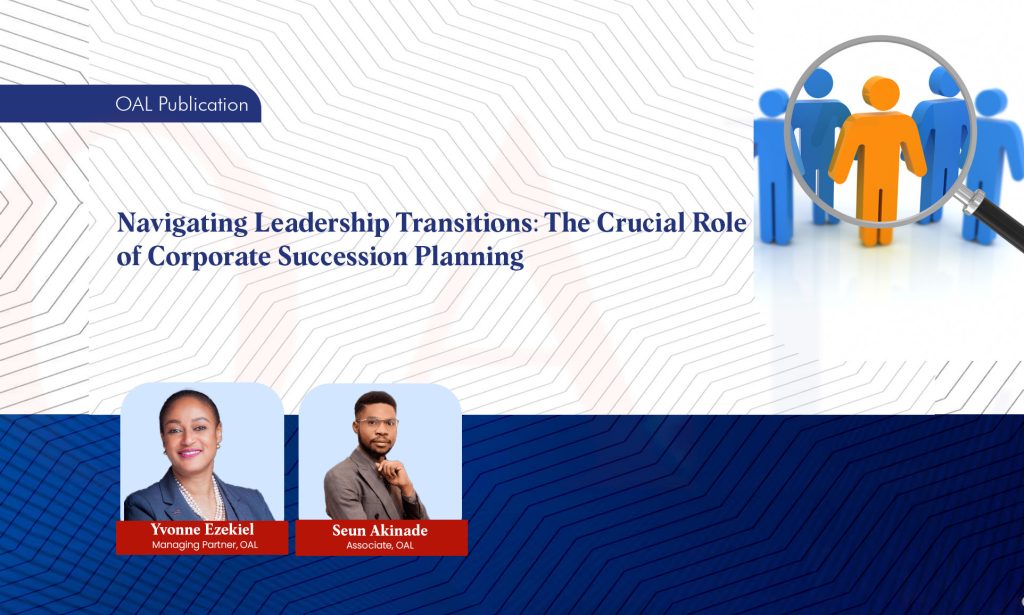In the ever-evolving landscape of corporate organisations, the art of succession planning emerges as an essential symphony conductor, orchestrating the transitions of leadership and safeguarding the harmonious progression of the business. This article delves into the intricate world of navigating leadership transition and the role of Succession Planning in a Corporate organisation. Beyond the surface of identifying successors, it explores the critical practice, considering its significance, major components, and the role the corporate lawyers play in maintaining an organisation’s unwavering course toward sustained success.
SIGNIFICANCE OF CORPORATE SUCCESSION PLANNING:
Succession planning for corporate organisations holds immense significance for several compelling reasons. Some of the reasons are:
- Continuity and Stability: Succession planning ensures that an organisation can continue its operations seamlessly in the face of unexpected and planned leadership changes, such as retirements, resignations, or emergencies. This continuity promotes stability and minimises disruptions.
- Preservation of Institutional Knowledge: Experienced leaders possess invaluable institutional knowledge and insights. Succession planning facilitates the transfer of this knowledge to their successors, preserving the organisation’s unique culture and expertise.
- Talent Development: A well-structured succession plan identifies and nurtures internal talent, preparing them for leadership roles effectively. This development process not only fills vacancies but also fosters a culture of growth and development within the organisation.
- Employee Morale and Engagement: When employees see that their organisation invests in their growth and career development, it boosts morale and engagement. This, in turn, leads to increased loyalty, higher retention rates, and a more motivated workforce.
- Risk Mitigation: Succession planning helps mitigate the risk associated with relying heavily on a single leader or a small group of key executives. Diversifying the pool of potential leaders reduces the organisation’s vulnerability.
- Long-Term Sustainability: By ensuring a smooth transition of leadership and nurturing talent from within, succession planning contributes to the long-term sustainability of the organisation. It positions the company for continued growth and prosperity.
Also read: From Vision to Reality: Highlighting the Challenges of AfCFTA
MAJOR COMPONENTS OF CORPORATE SUCCESSION PLANNING:
The key components of succession planning in corporate organisations encompass a structured and strategic approach to ensure a seamless transition of leadership and long-term sustainability. Here are some of the essential components:
- Identification of Key Roles: Identify critical positions within the organisation that require succession planning, typically top executive roles and other pivotal positions.
- Talent Assessment: Evaluate the skills, competencies, and potential of current employees to determine potential successors. This involves performance appraisals, skills assessments, and feedback from managers.
- Successor Development: Provide training, mentoring, and development opportunities to prepare identified successors for their future roles. This might include leadership programs, cross-functional assignments, or executive coaching. This includes Leadership Development Programs.
- Succession Plan Creation: Document the succession plan, outlining potential successors for each key role and the development activities needed to prepare them for these positions.
- Regular Review and Updates: Succession planning is an ongoing process. Regularly review and update the plan to reflect changes in the organisation’s needs and talent pool.
- Diversity and Inclusion: Promote diversity in your succession plan, considering candidates from various backgrounds and experiences to foster innovation and adaptability.
- External Benchmarking: Compare your succession plan and candidates against industry standards to ensure competitiveness.
- Testing the Plan: Run simulations or contingency exercises to ensure that the plan is practical and effective in real-world scenarios.
By integrating these key elements into their succession planning efforts, organisations can ensure a robust and comprehensive approach to preparing for leadership transitions and sustaining long-term success.
ROLES OF CORPORATE LAWYERS IN ENSURING SEAMLESS SUCCESSION PLANNING:
Corporate lawyers play crucial roles in succession planning for corporate organisations, serving as legal advisors and navigators throughout the process. Their roles encompass various legal aspects, ensuring compliance, risk mitigation, and a smooth transition of leadership. Here are some of the primary roles of corporate lawyers in succession planning:
- Legal Compliance: Corporate lawyers ensure that the succession plan complies with corporate governance principles, industry regulations, and relevant laws. They stay updated on legal requirements and ensure that the plan aligns with them.
- Governance Guidance: Corporate lawyers advise boards of directors and executives on their fiduciary duties and legal obligations during succession planning. They help maintain proper governance practices throughout the process.
- Contract Drafting and Review: Leadership transitions often involve executive contracts, employment agreements, and compensation packages. Corporate lawyers are responsible for drafting, reviewing, and negotiating these contracts to protect the organisation’s interests and ensure legal compliance.
- Dispute Resolution: In cases of disputes or disagreements arising during succession planning, corporate lawyers serve as mediators, working to find amicable resolutions and prevent potential legal disputes that could harm the organisation.
- Regulatory Compliance: Different industries have specific regulations regarding executive appointments and succession planning. Corporate lawyers ensure that the succession plan adheres to these industry-specific rules and avoids legal issues.
- Mitigating Legal Risks: Corporate lawyers help identify and mitigate legal risks associated with succession planning. They proactively address potential legal challenges such as complex inheritance laws and tax regulations when transferring assets and ownership to successors, jurisdiction in relation to cross-border succession planning, data privacy, and reducing the organisation’s exposure to legal liabilities.
- Documentation and Record-Keeping: Corporate lawyers oversee the legal documentation and record-keeping aspects of succession planning, ensuring that all legal documentation is accurate, up-to-date, and well-maintained.
Corporate lawyers are integral to the success of succession planning in corporate organisations. They provide critical legal guidance, safeguard the organisation’s interests, and ensure that the process adheres to legal requirements and best practices, ultimately contributing to a smooth and legally compliant transition of leadership.
In conclusion, succession planning is not merely a corporate formality; it is a strategic necessity. It’s the art of preparing for the future while safeguarding the present, ensuring that the organisation’s journey remains uninterrupted, and its legacy endures. From identifying emerging leaders to navigating the intricate web of legal and regulatory considerations, succession planning is the backbone of corporate resilience and longevity. When it comes to securing the future of your organisation, you can take the first step by reaching out to a law firm with extensive experience in developing robust succession strategies and facilitating effective implementation that steers organisations toward long-term success and sustainability.
Authors






